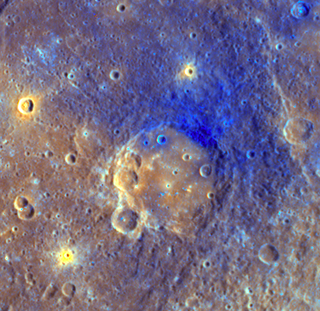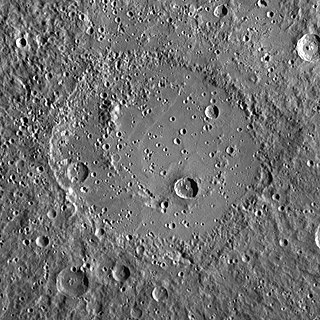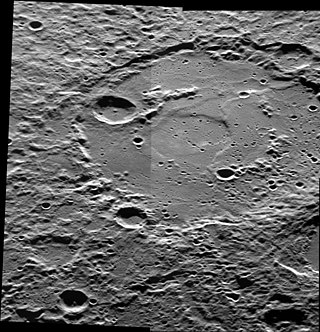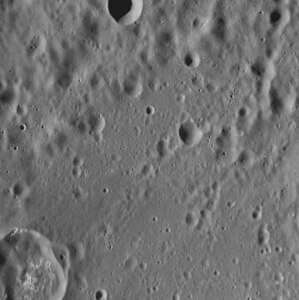
Tir Planitia is a large plain on the planet Mercury. The name Tir (تیر) is the Persian word for "Mercury",, and the name was approved in 1976. It was first observed in detail by Mariner 10. It lies between the large crater Mozart and the ancient Tolstoj basin.

Bach is a double-ringed impact basin within the Bach quadrangle of Mercury. It was named by the IAU in 1976.

Vivaldi is a crater on Mercury. It was named by the IAU after Italian composer Antonio Vivaldi in 1976. It has a prominent and nearly continuous inner ring whose diameter measures about half that of the outer ring. It is one of 110 peak ring basins on Mercury. Unlike some of the lunar multiringed structures, no vestiges of additional rings are apparent around this crater. It is classified as c3 age.

Mozart is a crater on Mercury, named by the IAU in 1976 after Austrian composer Wolfgang Amadeus Mozart.

Praxiteles is a crater on Mercury. It is one of 110 peak ring basins on Mercury.

Titian is an impact crater on the planet Mercury. It was named by the IAU in 1976.

Scarlatti is a pit-floored crater on Mercury, which was discovered in 1974 by the Mariner 10 spacecraft. It has a prominent peak ring, and it is one of 110 peak ring basins on Mercury. The crater floor is covered by the smooth plains material. The crater displays an arcuate collapse feature along the northeastern peak ring. The size of the pit, which was first noticed in MESSENGER images obtained in January 2008, is 38 × 12 km. Such a feature may have resulted from collapse of a magma chamber underlying the central peak ring complex of the crater. The collapse feature is an analog of Earth's volcanic calderas. Scarlatti is thought to have the same age as the Caloris basin.

Ahmad Baba is a crater on Mercury. It has a diameter of 127 kilometers. Its name was adopted by the International Astronomical Union (IAU) in 1979.

Aksakov is a crater on Mercury. It has a diameter of 174 kilometers. Its name was adopted by the International Astronomical Union (IAU) on April 24, 2012. Aksakov is named for the Russian author Sergey Aksakov, who lived from 1791 to 1859 C.E.

Bartók is a crater on Mercury. Its name was adopted by the International Astronomical Union (IAU) in 1979. Bartók is named for the Hungarian composer Béla Bartók, who lived from 1881 to 1945.

Chekhov is a crater on Mercury. It has a diameter of 194 kilometers. Its name was adopted by the International Astronomical Union (IAU) in 1976. Chekhov is named for the Russian author Anton Chekhov, who lived from 1860 to 1904.

Dürer is a crater on Mercury. It has a diameter of 195 kilometers. Its name was adopted by the International Astronomical Union (IAU) in 1976. Durer is named for the German artist Albrecht Dürer, who lived from 1471 to 1528.

Mark Twain is a crater on Mercury. Its name was adopted by the International Astronomical Union (IAU) in 1976. Mark Twain is named for the American author Mark Twain, who lived from 1835 to 1910.

Holst is a crater on Mercury. Its name was adopted by the International Astronomical Union (IAU) on April 24, 2012.

Ellington is a crater on Mercury named after Duke Ellington, an American composer, pianist, and leader of a jazz orchestra. It was named by the IAU in 2012.

Alver is a crater on Mercury. It has a diameter of 151.49 kilometers. Its name was adopted by the International Astronomical Union (IAU) on March 15, 2013. Alver is named for the Estonian poet Betti Alver.

Seuss is a crater on Mercury. Its name was adopted by the International Astronomical Union (IAU) in 2012. It is named for the American author and cartoonist Theodor Seuss Geisel, better known as Dr. Seuss.

Faulkner is a crater on Mercury. It has a diameter of 168 kilometres. Its name was adopted by the International Astronomical Union (IAU) on April 24, 2012. Faulkner is named for the American author William Faulkner.

Jobim is a crater on Mercury. It has a diameter of 167 kilometres. Its name was adopted by the International Astronomical Union (IAU) on September 25, 2015. Jobim is named for the Brazilian composer Antônio Carlos Jobim.

Steichen is a crater on Mercury. Its name was adopted by the International Astronomical Union (IAU) in 2010. The crater was named after American photographer and painter, Edward Steichen.























